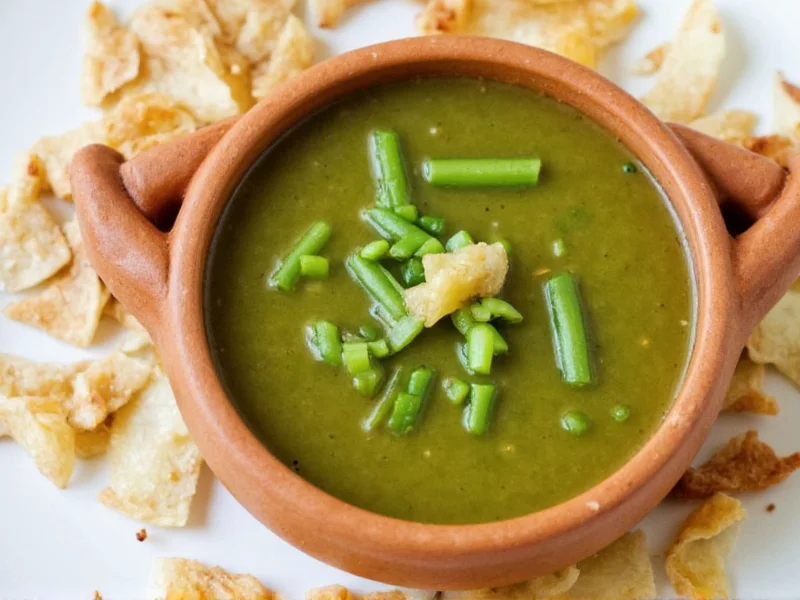The Complete Guide to Perfect Green Bean Soup
Green bean soup has been a kitchen staple across various cultures for generations, from French cuisine's soupe aux haricots verts to traditional American farmhouse cooking. This humble dish transforms a simple vegetable into a comforting, nutrient-dense meal that can be prepared in under 30 minutes with minimal ingredients. Understanding the proper techniques elevates this basic soup from平淡 to extraordinary, making it worthy of regular rotation in your meal planning.Nutritional Benefits of Green Bean Soup
Green beans serve as the nutritional powerhouse in this soup, delivering significant health advantages when properly prepared. A single cup of homemade green bean soup typically contains:| Nutrient | Amount per Serving | Daily Value % |
|---|---|---|
| Calories | 120 | 6% |
| Dietary Fiber | 4g | 14% |
| Vitamin A | 15% DV | 15% |
| Vitamin C | 25% DV | 25% |
| Folate | 20% DV | 20% |
| Iron | 8% DV | 8% |
Essential Ingredients for Authentic Flavor
Creating exceptional green bean soup requires attention to ingredient quality and selection:- Green beans - Choose young, slender beans for optimal tenderness. French haricots verts work particularly well due to their delicate texture and flavor. Avoid overripe beans with bulging pods.
- Aromatic base - Yellow onions provide sweetness, while leeks add subtle complexity. For depth, include one celery stalk finely diced.
- Garlic - Always use fresh cloves, minced or pressed. Add near the end of sautéing to prevent burning.
- Broth selection - Homemade vegetable or chicken stock yields superior results. For vegetarian versions, mushroom broth adds umami depth.
- Acid component - A splash of lemon juice or apple cider vinegar brightens flavors and enhances nutrient absorption.
Step-by-Step Preparation Method
Follow this professional technique for consistently excellent green bean soup:- Prep ingredients - Trim ends from 1 pound green beans and cut into 1-inch pieces. Finely dice 1 medium onion, 1 celery stalk, and 2 garlic cloves.
- Saute aromatics - Heat 2 tablespoons olive oil in a heavy-bottomed pot over medium heat. Add onions and celery with a pinch of salt, cooking until translucent (5-7 minutes).
- Add green beans - Stir in prepared green beans and cook for 3 minutes to enhance flavor through the Maillard reaction.
- Simmer properly - Add 4 cups broth, bring to a gentle simmer (not boil), and cook uncovered for 15-18 minutes until beans are tender-crisp.
- Finish with care - Remove from heat, stir in 1 tablespoon lemon juice and fresh herbs. Season with sea salt and cracked pepper to taste.
Variations for Different Dietary Needs
Green bean soup adapts beautifully to various dietary requirements:- Creamy vegan version - Blend half the cooked soup with 1/4 cup cooked white beans for creaminess without dairy
- Protein-enhanced - Add 1/2 cup cooked white beans or 3 ounces diced turkey after cooking
- French-inspired - Include 1/4 cup finely diced ham and finish with tarragon
- Asian fusion - Substitute ginger for garlic and use mushroom broth with rice vinegar
- Low-sodium option - Use homemade broth and enhance flavor with nutritional yeast
Storage and Reheating Best Practices
Proper storage maintains both safety and quality:- Cool soup completely within 2 hours of cooking
- Store in airtight containers for up to 4 days in the refrigerator
- Freeze in portion-sized containers for up to 3 months
- Reheat gently over medium-low heat to preserve texture
- Add fresh herbs and a splash of broth when reheating frozen portions
Troubleshooting Common Issues
Address these frequent green bean soup challenges:- Mushy texture - Overcooking is the primary culprit. Reduce simmering time and test beans with a fork at 12 minutes.
- Bland flavor - Build layers of flavor by properly sautéing aromatics and finishing with acid. Try adding a Parmesan rind while simmering.
- Darkened color - Chlorophyll breaks down in acidic environments. Add acid components only after cooking completes.
- Watery consistency - Simmer uncovered for additional 5-7 minutes to reduce, or blend a portion of the soup to thicken naturally.
Frequently Asked Questions
Can I use frozen green beans for homemade soup?
Yes, frozen green beans work well in soup preparation. Add them directly to the broth without thawing to maintain texture. Frozen beans often retain nutrients better than off-season fresh beans, making them a practical year-round option for healthy green bean soup recipes.
How do I prevent green beans from becoming tough in soup?
To maintain tender-crisp texture, add trimmed green beans to already simmering broth rather than cold liquid. Cook just until tender (15-18 minutes for fresh beans), testing with a fork. Older, thicker beans may require slightly longer cooking, while young haricots verts need less time.
What's the best way to enhance flavor without adding salt?
Build flavor depth through proper technique: sauté aromatics until golden, use high-quality homemade broth, add umami boosters like dried mushrooms or tomato paste, and finish with fresh acid (lemon juice or vinegar). Fresh herbs added at the end also provide significant flavor enhancement without sodium.
Can green bean soup be made in an Instant Pot?
Yes, green bean soup adapts well to pressure cooking. Use the sauté function for aromatics, add broth and beans, then cook at high pressure for 3 minutes with a quick release. This method preserves more nutrients than traditional boiling while significantly reducing cooking time for quick green bean soup preparation.
How can I make green bean soup creamier without dairy?
For dairy-free creaminess, blend 1/3 to 1/2 of the cooked soup until smooth, then return to the pot. Alternatively, add 1/4 cup cooked white beans or cauliflower before blending. These methods create luxurious texture while maintaining the soup's vegan status and enhancing nutritional profile with additional fiber and nutrients.











 浙公网安备
33010002000092号
浙公网安备
33010002000092号 浙B2-20120091-4
浙B2-20120091-4